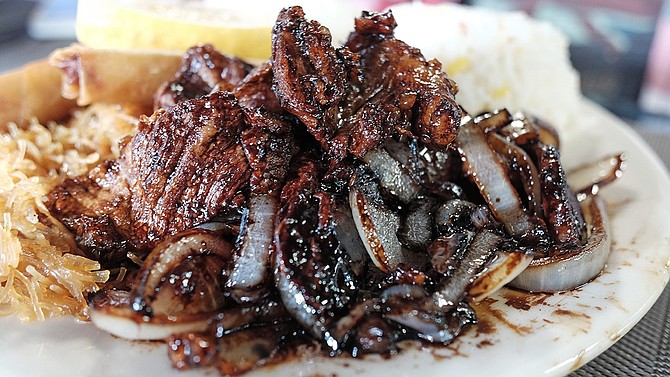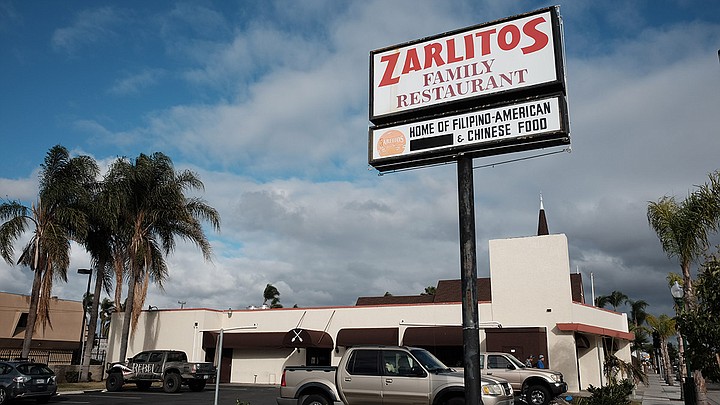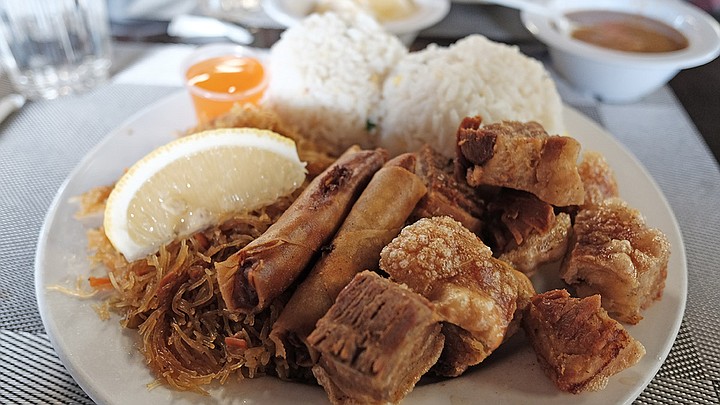 Facebook
Facebook
 X
X
 Instagram
Instagram
 TikTok
TikTok
 Youtube
Youtube

When I sat down at Zarlitos Family Restaurant and looked over the menu, I found lots of wonderful-sounding dishes. By that I mean the words themselves sounded wonderful: sinigang na baboy, tortang alimango, daing na bangus.
I’ve heard about Zarlitos’ award-winning poke, but I had no idea what many of its traditional Filipino dishes were, and there are a lot of them. A menu explained: pork in tamarind soup, crab omelet, and fried milkfish, respectively. Any of these would have suited me just fine, but rather than blindly pick, I asked my server for a recommendation.

She sized me up for a moment and then pointed her finger to the combination menu, number nine. Would it be dinuguan or maybe kare-kare? Nope. She suggested that I order beef steak with onions.
I get that I don’t look adventurous enough to try a stew of pork in beef blood or oxtail with peanut sauce, but beef steak and onions? How boring.
I did like the suggestion to choose a combo platter though. Most of Zarlitos' $8 to $10 entrées are served without sides, meant to be ordered and shared, family style. The combo platters, on the other hand, include sides of pancit noodles, garlic fried rice, and lumpia — a little more diversity on the plate when you're ordering for one. After discounting the familiar adobo dishes, a couple of beef options, and that bony milkfish, I opted for the most interesting sounding choice on the combo menu: lechon kawali, described as chunks of crispy fried pork belly for $8.25. I figure it’s tough to go wrong with pork belly.

Crispy doesn’t begin to describe its crackling skin. Inside, the melting pork fat disintegrated in a flash of flavor. Outside was all salty crunch, but that went well with a side of the house Mang Tomas sauce, a mildly sweet dipping sauce made with liver and vinegar.
Meanwhile, one of my friends ordered that beef steak with onions for $10. Here’s where I have to give our waitress credit — it was the best thing I tried. The boring name aside, the thin slices of sautéed beef didn’t taste like something usually found on this side of the Pacific. I’ve noticed a lot of bright, acidic flavors in Filipino cuisine, and this beef went that route. It was tender, pleasantly fatty, and loaded with caramelized onion flavor yet it had an interesting tang I’d like to experience again.
My friends didn’t enjoy it as much as I did, and I’d expect a lot of people might agree with them based on the amount of fried food and lack of fresh produce we encountered. Even the Vegetables section of the menu consists of pork, beef, and shrimp dishes.
But I was encouraged, and I left too many interesting sounding dishes untested. I might not like manok na luto sa gata, but if I don’t go back to try it at Zarlitos, I might never know for sure.


When I sat down at Zarlitos Family Restaurant and looked over the menu, I found lots of wonderful-sounding dishes. By that I mean the words themselves sounded wonderful: sinigang na baboy, tortang alimango, daing na bangus.
I’ve heard about Zarlitos’ award-winning poke, but I had no idea what many of its traditional Filipino dishes were, and there are a lot of them. A menu explained: pork in tamarind soup, crab omelet, and fried milkfish, respectively. Any of these would have suited me just fine, but rather than blindly pick, I asked my server for a recommendation.

She sized me up for a moment and then pointed her finger to the combination menu, number nine. Would it be dinuguan or maybe kare-kare? Nope. She suggested that I order beef steak with onions.
I get that I don’t look adventurous enough to try a stew of pork in beef blood or oxtail with peanut sauce, but beef steak and onions? How boring.
I did like the suggestion to choose a combo platter though. Most of Zarlitos' $8 to $10 entrées are served without sides, meant to be ordered and shared, family style. The combo platters, on the other hand, include sides of pancit noodles, garlic fried rice, and lumpia — a little more diversity on the plate when you're ordering for one. After discounting the familiar adobo dishes, a couple of beef options, and that bony milkfish, I opted for the most interesting sounding choice on the combo menu: lechon kawali, described as chunks of crispy fried pork belly for $8.25. I figure it’s tough to go wrong with pork belly.

Crispy doesn’t begin to describe its crackling skin. Inside, the melting pork fat disintegrated in a flash of flavor. Outside was all salty crunch, but that went well with a side of the house Mang Tomas sauce, a mildly sweet dipping sauce made with liver and vinegar.
Meanwhile, one of my friends ordered that beef steak with onions for $10. Here’s where I have to give our waitress credit — it was the best thing I tried. The boring name aside, the thin slices of sautéed beef didn’t taste like something usually found on this side of the Pacific. I’ve noticed a lot of bright, acidic flavors in Filipino cuisine, and this beef went that route. It was tender, pleasantly fatty, and loaded with caramelized onion flavor yet it had an interesting tang I’d like to experience again.
My friends didn’t enjoy it as much as I did, and I’d expect a lot of people might agree with them based on the amount of fried food and lack of fresh produce we encountered. Even the Vegetables section of the menu consists of pork, beef, and shrimp dishes.
But I was encouraged, and I left too many interesting sounding dishes untested. I might not like manok na luto sa gata, but if I don’t go back to try it at Zarlitos, I might never know for sure.
Comments